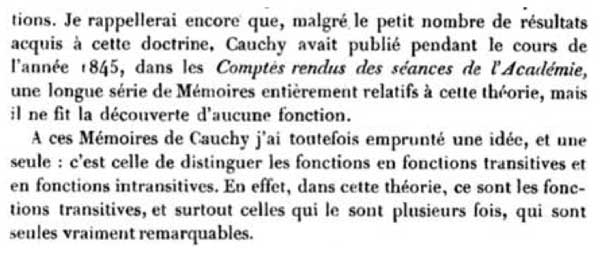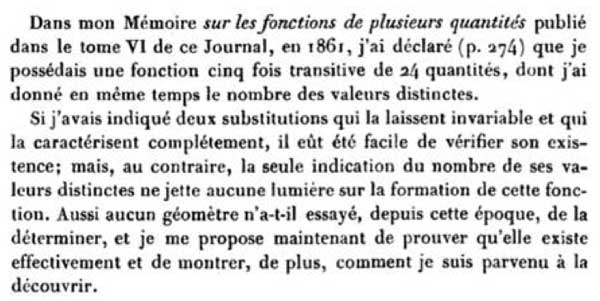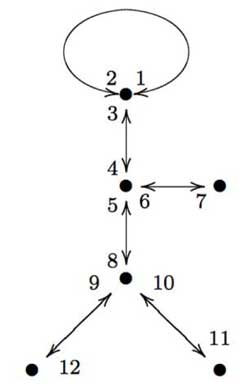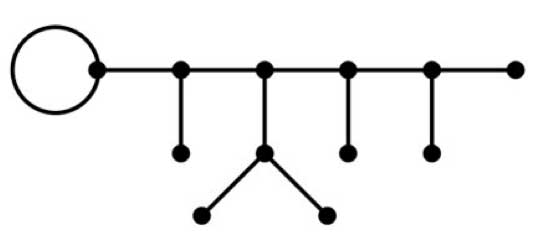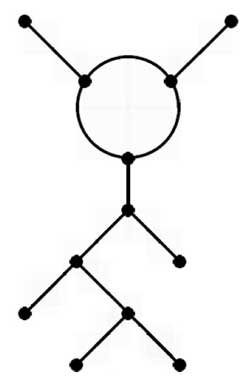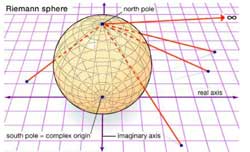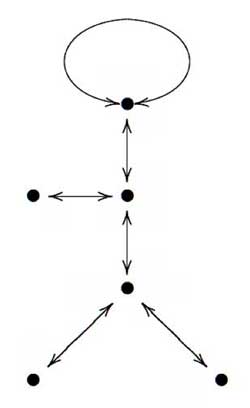(continued from part one). Take twelve cards and give them values 0,1,2,…,11 (for example, take the jack to have value 11 and the queen to have value 0). The hexads are 6-tuples of cards having the following properties. When we star their values by the scheme on the left below and write a 0 below a column if it has just one star at the first row or two stars on rows two and three (a + if the unique star is at the first row or two stars in the other columns, and a – if the unique star in on the second row or two stars in rows one and two) or a ? if the column has 3 or 0 stars, we get a tetracodeword where we are allowed to replace a ? by any digit. Moreover, we want that the stars are NOT distributed over the four columns such that all of the possible outcomes 0,1,2,3 appear once. For example, the card-pile { queen, 3, 4, 7, 9, jack } is an hexad as is indicated on the right below and has column-distributions (1,1,2,2).
$\begin{array}{|c|ccc|} \hline 6 & 3 & 0 & 9 \\ 5 & 2 & 7 & 10 \\ 4 & 1 & 8 & 11 \\ \hline & & & \end{array} $ $\begin{array}{|c|ccc|} \hline & \ast & \ast & \ast \\ & & \ast & \\ \ast & & & \ast \\ \hline – & 0 & – & + \end{array} $
The hexads form a Steiner-system S(5,6,12), meaning that every 5-pile of cards is part of a unique hexad. The permutations on these twelve cards, having the property that they send every hexad to another hexad, form the sporadic simple group $M_{12} $, the _Mathieu group_ of order 95040. For now, we assume these facts and deduce from them the Conway-Ryba winning strategy for Mathieu’s blackjack : the hexads are exactly the winning positions and from a non-hexad pile of total value at least 21 there is always a legal (that is, total value decreasing) move to an hexad by replacing one card in the pile by a card from the complement.
It seems that the first proof of this strategy consisted in calculating the Grundy values of all 905 legal positions in Mathieu’s blackjack. Later Joseph Kahane and Alex Ryba gave a more conceptual proof, that we will try to understand.
Take a non-hexad 6-pile such that the total value of its cards is at least 21, then removing any one of the six cards gives a 5-pile and is by the Steiner-property contained in a unique hexad. Hence we get 6 different hexads replacing one card from the non-hexad pile by a card not contained in it. We claim that at least one of these operations is a legal move, meaning that the total value of the cards decreases. Let us call a counterexample a misfit and record some of its properties until we can prove its non-existence.
A misfit is a non-hexad with total value at least 21 such that all 6 hexads, obtained from it by replacing one card by a card from its complement, have greater total value
A misfit must contain the queen-card. If not, we could get an hexad replacing one misfit-card (value > 0) by the queen (value zero) so this would be a legal move. Further, the misfit cannot contain the jack-card for otherwise replacing it by a lower-valued card to obtain an hexad is a legal move.
A misfit contains at least three cards from {queen,1,2,3,4}. If not, three of these cards are the replacements of misfit-cards to get an hexad, but then at least one of the replaced cards has a greater value than the replacement, giving a legal move to an hexad.
A misfit contains more than three cards from {queen=0, 1,2,3,4}. Assume there are precisely three $\{ c_1,c_2,c_3 \} $ from this set, then the complement of the misfit in the hexad {queen,1,2,3,4,jack} consists of three elements $\{ d_1,d_2,d_3 \} $ (a misfit cannot contain the jack). The two leftmost columns of the value-scheme (left above) form the hexad {1,2,3,4,5,6} and because the Mathieu group acts 5-transitively there is an element of $M_{12} $ taking $\{ 0,1,2,3,4,11 \} \rightarrow \{ 1,2,3,4,5,6 \} $ and we may even assume that it takes $\{ c_1,c_2,c_3 \} \rightarrow \{ 4,5,6 \} $. But then, in the new value-scheme (determined by that $M_{12} $-element) the two leftmost columns of the misfit look like
$\begin{array}{|c|ccc|} \hline \ast & . & ? & ? \\ \ast & . & ? & ? \\ \ast & . & ? & ? \\ \hline ? & ? & & \end{array} $
and the column-distribution of the misfit must be either (3,0,2,1) or (3,0,1,2) (it cannot be (3,0,3,0) or (3,0,0,3) otherwise the (image of the) misfit would be an hexad). Let {i,j} be the two misfit-values in the 2-starred column. Replacing either of them to get an hexad must have the replacement lying in the second column (in order to get a valid column distribution (3,1,1,1)). Now, the second column consists of two small values (from {0,1,2,3,4}) and the large jack-value (11). So, at least one of {i,j} is replaced by a smaller valued card to get an hexad, which cannot happen by the misfit-property.
Now, if the misfit shares four cards with {queen,1,2,3,4} then it cannot contain the 10-card. Otherwise, the replacement to get an hexad of the 10-card must be the 11-card (by the misfit-property) but then there would be another hexads containing five cards from {queen,0,1,2,3,jack} which cannot happen by the Steiner-property. Right, let’s summarize what we know so far about our misfit. Its value-scheme looks like
$\begin{array}{|c|ccc|} \hline 6 & III & \ast & 9 \\ 5 & II & 7 & . \\ IV & I & 8 & . \\ \hline & & & \end{array} $ and it must contain three of the four Romans. At this point Kahane and Ryba claim that the two remaining cards (apart from the queen and the three romans) must be such that there is exactly one from {5,6} and exactly one from {7,8,9}. They argue this follows from duality where the dual pile of a card-pile $\{ x_1,x_2,\ldots,x_6 \} $ is the pile $\{ 11-x_1,11-x_2,\ldots,11-x_6 \} $. This duality acts on the hexads as the permutation $~(0,11)(1,10)(2,9)(3,8)(4,7)(5,6) \in M_{12} $. Still, it is unclear to me how they deduce from it the above claim (lines 13-15 of page 4 of their paper). I’d better have some coffee and work around this (to be continued…)
If you want to play around a bit with hexads and the blackjack game, you’d better first download SAGE (if you haven’t done so already) and then get David Joyner’s hexad.sage file and put it in a folder under your sage installation (David suggests ‘spam’ himself…). You can load the routines into sage by typing from the sage-prompt attach ‘spam/hexad.sage’. Now, you can find the hexad from a 5-pile via the command find_hexad([a1,a2,a3,a4,a5],minimog_shuffle) and you can get the winning move for a blackjack-position via blackjack_move([a1,a2,a3,a4,a5,a6],minimog_shuffle). More details are in the Joyner-Casey(Luers) paper referenced last time.
Reference
Joseph Kahane and Alexander J. Ryba, ‘The hexad game‘
Leave a Comment






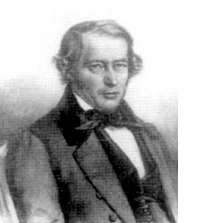 Observe that the final row of the start position is $-~00+ $ which is NOT a tetracodeword, whereas that of the winning position $-~0-+ $ IS a tetracodeword! This is the essence of the _Conway-Ryba winning strategy_ for Mathieu’s blackjack. There are precisely 132 winning positions forming the
Observe that the final row of the start position is $-~00+ $ which is NOT a tetracodeword, whereas that of the winning position $-~0-+ $ IS a tetracodeword! This is the essence of the _Conway-Ryba winning strategy_ for Mathieu’s blackjack. There are precisely 132 winning positions forming the 